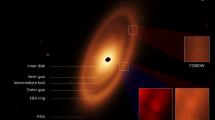Abstract
THERE has been speculation for some time about the possibility of detecting the motion of zodiacal dust particles by accurately measuring the wavelength position of a solar Fraunhofer absorption line scattered in the cloud. Ingham1 derived the Hβ absorption line profile that would result from solar radiation scattered by dust particles in circular Keplerian orbits about the Sun. He showed that, in the ecliptic, at an elongation of 30° from the Sun, the expected wavelength shift is 0.3 Å to the blue for dust particles co-rotating with the Earth, and 0.8 Å to the red for contra-rotating dust. Ring et al.2 made measurements on the Hβ absorption line from Mount Chacaltaya, in the Bolivian Andes, and found a blue wavelength shift in the evening zodiacal light, a possible interpretation of which could be in terms of a zodiacal dust cloud co-rotating with the Earth at twice the expected circular orbital velocity. During a programme of observations to map the night sky Hβ emission line3, many spectra were recorded in the region of the evening zodiacal light between elongations of 35° and 180° from the Sun. The observations were made with a gas pressure scanned Fabry–Perot interferometer4, working at a resolving power of 8,000, from an 11,500 foot observatory on Testa Grigia in the Italian Alps (lat. 45° N.). The instrument scanned, in steps of 0.14 Å, a range of 2 Å centred on the 4861.33 Å laboratory Hβ wavelength, thus providing about 14 closely spaced points across the spectral feature. Wavelength calibrations were made before and after each spectrum was recorded.
This is a preview of subscription content, access via your institution
Access options
Subscribe to this journal
Receive 51 print issues and online access
$199.00 per year
only $3.90 per issue
Buy this article
- Purchase on SpringerLink
- Instant access to full article PDF
Prices may be subject to local taxes which are calculated during checkout
Similar content being viewed by others
References
Ingham, M. F., Mon. Not. Roy. Astro. Soc., 126, 377 (1963).
Ring, J., Clarke, D., James, J. F., Daehler, M., and Mack, J. E., Nature, 202, 167 (1964).
Hindle, P. H., Reay, N. K., and Ring, J., Planet. Spa. Sci., 16, 795 (1968).
Hindle, P. H., and Reay, N. K., J. Sci. Inst., 44, 360 (1967).
Author information
Authors and Affiliations
Rights and permissions
About this article
Cite this article
REAY, N., RING, J. Radial Velocity Measurements on the Zodiacal Light Spectrum. Nature 219, 710 (1968). https://doi.org/10.1038/219710a0
Received:
Issue date:
DOI: https://doi.org/10.1038/219710a0
This article is cited by
-
Zodiacal light ? A measure of the interplanetary environment
Space Science Reviews (1975)
-
Earth's Dust Cloud
Nature (1971)
-
Motion of the Interplanetary Dust Cloud
Nature (1970)
-
Possibility of a Terrestrial Component in the Doppler Shifted Zodiacal Light
Nature (1970)
-
Infra-red astronomical background radiation
La Rivista del Nuovo Cimento (1970)



